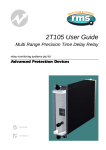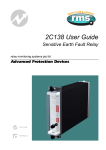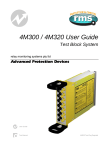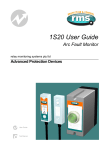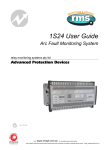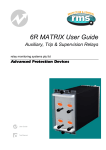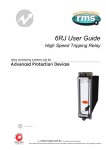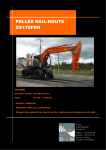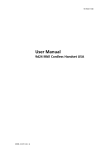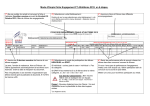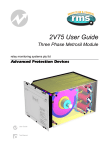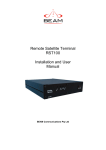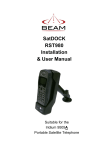Download 2C73 User's Guide
Transcript
2C64 User Guide Definite Time Current Check Relay relay monitoring systems pty ltd Advanced Protection Devices User Guide Test Manual 2C64 User Guide About This Manual This User Guide covers all 2C64 relays manufactured from May 2003. Earlier relays do not necessarily incorporate all the features described. Our policy of continuous may means that extra features & functionality may have been added. The 2C64 User Guide is designed as a generic document to describe the common operating parameters for all relays built on this platform. Some relay applications are described but for specific model information the individual “K” number Product / Test manuals should be consulted. The copyright and other intellectual property rights in this document, and in any model or article produced from it (and including any Registered or unregistered design rights) are the property of Relay Monitoring Systems Pty Ltd. No part of this document shall be reproduced or modified or stored in another form, in any data retrieval system, without the permission of Relay Monitoring Systems Pty Ltd, nor shall any model or article be reproduced from this document without consent from Relay Monitoring Systems Pty Ltd. While the information and guidance given in this document is believed to be correct, no liability shall be accepted for any loss or damage caused by any error or omission, whether such error or omission is the result of negligence or any other cause. Any and all such liability is disclaimed. Contact Us Relay Monitoring Systems Pty Ltd 2001-2003 6 Anzed Court • Mulgrave 3170 • AUSTRALIA Phone 61 3 9561 0266 • Fax 61 3 9561 0277 Email [email protected] • Web www.rmspl.com.au To download a PDF version of this guide: http://www.rmspl.com.au/userguide/2C64_user_guide.pdf To download the model specific Test Manual: http://www.rmspl.com.au/search.asp How this guide is organised This guide is divided into five parts: Part 1 Overview About this Manual Contents Test Manual Part 2 Mechanical Configuration Part 3 Technical Bulletin Part 4 Installation Handling of Electronic Equipment Safety Unpacking Accessories Storage & Handling Recommended Mounting Position Relay Dimensions & Other Mounting Accessories Equipment Connections Part 5 Maintenance Mechanical Inspection Test Intervals Defect Report Form Visit www.rmspl.com.au for the latest product information. Due to RMS continuous product improvement policy this information is subject to change without notice. 2C63_Guide/Iss B/10/06/03 Part 1 Test Manual This User Guide covers all 2C64 relay versions & describes the generic features & attributes common across all versions. Different relay versions are required to cater for varying customer requirements such as auxiliary voltage range, I/O configuration, case style, relay functionality etc. The product ordering code described in the Technical Bulletin is used to generate a unique version of the relay specification & is called a type number. The type number takes the form 2C64Kxx where the Kxx is the “K” or version number. Refer to: www.rmspl.com.au/handbook/PARTA3.pdf for a complete description of the RMS “K” number system. Each 2C64 version has a specific Test Manual which provides details on the unique attributes of the relay. Each Test Manual includes the following information: • Test Certificate • Specific technical variations from the standard model if applicable • Test & calibration record • Wiring diagram A Test Manual is provided with each relay shipped. If you require a copy of the Test Manual for an RMS product the following options are available: • Check the RMS web site at: www.rmspl.com.au/search.asp • RMS CD catalogue select: List all Product/Test Manuals under Technical Library • Contact RMS or a representative & request a hard copy or PDF by email. Visit www.rmspl.com.au for the latest product information. Due to RMS continuous product improvement policy this information is subject to change without notice. 2C63_Guide/Iss B/10/06/03 Part 2 Mechanical Configuration Great care has been taken to design a rugged, cost effective & flexible mechanical solution for the MATRIX range of RMS protection relays. The MATRIX range provides a compact draw out case solution with M4 screw terminals: • • • 2M28 4M28 4M56 Size 2 with 28 terminals Size 4 with 28 terminals Size 4 with 56 terminals Complete details & attributes for the M (MATRIX) cases & accessories may be found at: http://www.rmspl.com.au/mseries.htm The 2C64 is configured in a 4M56 case & the following photographs depict the general mechanical configuration. It should be noted that re-usable screw rivets are used to bind the draw out relay module. A 1/16” hex key is required for disassembly. 2C64 Module top view Visit www.rmspl.com.au for the latest product information. Due to RMS continuous product improvement policy this information is subject to change without notice. 2C63_Guide/Iss B/10/06/03 2C64 CT PCB & current setting controls 2C64 Power supply (Timer circuitry not loaded for the 2C64) Visit www.rmspl.com.au for the latest product information. Due to RMS continuous product improvement policy this information is subject to change without notice. 2C63_Guide/Iss B/10/06/03 Part 3 Technical Bulletin The detailed technical attributes, functional description & performance specifications for the 2C64 are described in the attached Technical Bulletin. For the most up to date version go to: www.rmspl.com.au/handbook/2C64.htm For any specific attributes of a particular version refer to the Test Manual for that type (K) number. The order of precedence for technical information is as follows: • • • Test Manual Technical Bulletin User Guide Visit www.rmspl.com.au for the latest product information. Due to RMS continuous product improvement policy this information is subject to change without notice. 2C63_Guide/Iss B/10/06/03 2C64 Technical Bulletin Instantaneous Current Check Relay Features 10:1 PU setting ranges Select from two options: 5 - 50% or 20 - 200% of nominal input current 1A or 5A nominal CT’s Fast reset times (<15ms at 20x setting, repeated offset) <5% transient over-reach 3 configurable instantaneous C/O contacts (Common or phase segregated) Relay initiate status input 40-300V DC auxiliary supply Power supply fail relay drops out if the Auxiliary supply fails. Optional 20-70V DC supply Size 4M draw out case Made in Australia Application The 2C64 Series relays are adjustable AC current sensing relays for application in breaker fail protection schemes. The 2C64 is particularly suitable for breaker fail schemes where single/three pole breaker tripping is possible, since control of the current detector is provided on a per phase basis. The 2C64 current check relay detects the circuit breaker failure to trip & to ensure discrimination has a fast reset time & minimum overshoot time. A status input signal is required to enable the output relay contacts. This allows the current pickup to be adjusted to a sensitive setting without the risk of false output relay operation due to transients & harmonics. 2C64 in a 4M56 case Operation Made in Australia The 2C64 Series relay is a three pole current detector designed specifically for CB fail applications. A critical requirement is for a fast reset characteristic which is achieved through the use of air core CT’s. The low burden auxiliary supply makes the relay suitable for continuous energisation. Fully solid state sensing & measuring circuitry is employed with each phase current setting continuously adjustable on a front panel control. Integrated Time Delay Relay The 2C63 definite time current check relay may be specified where an integrated delay timer is preferred. This relay has identical performance characteristics plus the time delay function & additional output contacts. Two output configurations are available: Zero Stand by Burden Relay The 2C80 current check relay may be specified where a zero stand by burden is required. Initiation of the relay is achieved through application of the auxiliary supply on a single or three phase basis. The linear power supply provides high speed start up but results in higher operating burden & non continuous rating. The 2C80 may be specified with or without an integrated time delay element. 3 C/O 3φ instantaneous outputs or 3 x 1 C/O instantaneous phase segregated Breakers can fail to clear a fault for several reasons: The trip circuit can be open due to broken wire, blown fuse, open trip coil The interrupting mechanism can stick, leaving a single phase of a three phase circuit connected The interrupter can flash-over due to loss of dielectric strength through contamination or damage The operating mechanism can fail to operate The purpose of the CB fail relay is to detect this condition & initiate contingency or backup procedures. The wide range switchmode power supply, input current transformer, output relays & status inputs form the essential barriers against high voltage line transients. www.rmspl.com.au Visit for the latest product information. Due to RMS continuous product improvement policy this information is subject to change without notice. 2C64/Issue E/30/11/04/1/4 Operating Logic INSTANTANEOUS OUTPUT CONTACT FUNCTION The instantaneous output contacts can be configured to operate in two modes: 1. P/U when the current exceeds the user selectable setting & the internal instantaneous contacts link is set to BYPASS; 2. If the link is moved to USE, the instantaneous contacts will only P/U when both the current exceeds the user selectable setting & a voltage is applied to the relay initiate status input. BYPASS O/C INITIATE INST. OUTPUTS & RELAY INITIATE USE STATUS INPUT FUNCTION The status input function is factory set to enable the output relay contacts during the application of a control voltage. This allows the current pickup to be adjusted to a sensitive setting without the risk of false output relay operation due to transients & harmonics. INSTANTANEOUS OUTPUT CONTACTS Three (3) self reset C/O contacts (Schrack type). ♦ Specify 3 C/O 3φ instantaneous output or ♦ 3 x 1 C/O instantaneous phase segregated INSTANTANEOUS OUTPUT CONTACT RATINGS Make & carry 30A AC or DC (Limits L/R=40ms & 300V max.) for 0.2s 20A AC or DC (Limits L/R=40ms & 300V max.) for 0.5s 5A AC or DC continuously Break (Limits 5A & 300V max.) 1,250VA AC resistive 250VA at 0.4PF AC inductive 75W DC resistive 30W DC inductive L/R = 40ms 50W DC inductive L/R = 10ms Minimum recommended load 0.5W, 10mA or 5V minimum. www.rmspl.com.au Visit for the latest product information. Due to RMS continuous product improvement policy this information is subject to change without notice. 2C64/Issue E/30/11/04/2/4 Technical Data BURDENS Auxiliary supply: (at 110V DC nominal supply) Less than 2.5 watts when dropped out. Less than 3.5 watts with output relays energized. Sensing circuits: VA per phase all settings. I amps 1 5 10 20 25 30 1A CT input 1.25 6 25 100 - 5A CT input 0.01 0.18 0.70 2.9 4.5 6.5 1A CT 3.5 39 75 90 120 180 POWER SUPPLY FAIL ALARM CONTACT One C/O contact picked up when auxiliary supply healthy. (Schrack type). INSULATION WITHSTAND IEC60255-5 2KV RMS & 1.2/50 5KV impulse between: ♦ all input terminals & frame ♦ all output terminals & frame ♦ all input & output terminals ♦ each input group ♦ each output group CT INPUT THERMAL WITHSTAND (Per phase) Continuous 4.5s 3s 2s 1s 0.5s AUXILIARY SUPPLY 40 – 275V AC & 40-300V DC switchmode supply with power on LED 20 – 70V DC switchmode supply with power on LED. 5A CT * 25 250 450 550 800 1,000 HIGH FREQUENCY DISTURBANCE IEC60255-22-1 2.5KV 1MHz common mode 1.0KV 1MHz differential mode ELECTROSTATIC DISCHARGE EN61000-4-2:1995 8KV Level 3 RADIO FREQUENCY INTERFERENCE EN61000-4-3:1995 10V/m Level 3 FAST TRANSIENT DISTURBANCE EN61000-4-4:1995 4KV Level 4 Note: * M Series case terminals & CT shorting switches are limited to 400A for 1s. AMBIENT OPERATING TEMPERATURE RANGE -5 to 55 degrees C. OPERATING TIME OF INSTANTANEOUS CURRENT ELEMENT At 2 X Setting: Less than 20ms on pick up. Drop out less than 15 ms when: Relay is energized by symmetrical or fully offset current of either polarity, or by three successive applications of fully offset currents of same polarity with time interval of not less than 5 sec between each application. (Current duration of 5 cycles). Steady state current magnitudes up to 20 x setting are switched off at or near a current zero with the current prior to switch off being + ve going, & at or near a current zero with the current prior to switch off being-ve going. (X/R ratios of the circuit from which the relay is energized lie in the range 10 to 30). HUMIDITY 40 degrees C & 95% RH non condensing DROPOUT PICKUP RATIO 85% approximately. For large shipment individual cartons are packed in sturdy cardboard pallet boxes & surrounded by loose fill to absorb vibration & shock during transit. ACCURACY OF SETTINGS Repeatability: + 2% of setting Setting: + 5% of maximum setting www.rmspl.com.au CASE Size 4 draw out 28 M4 screw terminals Flush panel mount or 4U high 1/4 width 19 inch rack mount IP51 rating SHIPPING DETAILS Each relay is supplied individually packed in pre formed cardboard cartons with internal moulded polystyrene former. Weight: 3.3Kg Size: 370(L) x 240(W) x 145(D)mm - Size 4 case ACCESSORIES SUPPLIED WITH EACH RELAY 1 x M4 self threading mounting screw kit P/N 290-406-151 2 x M4 terminal screw kit (28 per kit) P/N 290-407-153 Visit for the latest product information. Due to RMS continuous product improvement policy this information is subject to change without notice. 2C64/Issue E/30/11/04/3/4 Ordering Information Generate the required ordering code as follows: e.g. 2C64 BAABD 1 2 3 4 5 2C64 1 AUXILIARY SUPPLY RANGE A 20-70V DC B 40-300V DC 2 CURRENT SETTING (% of nominal) A 5-50% 3 CT RATING (Nominal) A 1A B 20-200% B 5A 4 EXTRA CUSTOMER SPECIFIED OUTPUT CONTACTS A B 3 C/O 3φ instantaneous output 3 x 1 C/O instantaneous phase segregated 5 RELAY INITIATE STATUS INPUT Relay coil input A C Always enabled 48V DC B 24V DC D 110V DC Integrated Time Delay Relay The 2C63 definite time current check relay may be specified where an integrated delay timer is preferred. This relay has identical performance characteristics plus the time delay function & additional output contacts. Zero Standby Burden Relay The 2C80 current check relay may be specified where a zero standby burden is required. Initiation of the relay is achieved through application of the auxiliary supply on a single or three phase basis. The linear power supply provides high speed start up but results in higher operating burden & non continuous rating. The 2C80 may be specified with or without an integrated time delay element. www.rmspl.com.au Visit for the latest product information. Due to RMS continuous product improvement policy this information is subject to change without notice. 2C64/Issue E/30/11/04/4/4 Part 4 Installation Handling of Electronic Equipment A person’s normal movements can easily generate electrostatic potentials of several thousand volts. Discharge of these voltages into semiconductor devices when handling electronic circuits can cause serious damage, which often may not be immediately apparent but the reliability of the circuit will have been reduced. The electronic circuits of Relay Monitoring Systems Pty Ltd products are immune to the relevant levels of electrostatic discharge when housed in the case. Do not expose them to the risk of damage by withdrawing modules unnecessarily. Each module incorporates the highest practicable protection for its semiconductor devices. However, if it becomes necessary to withdraw a module, the following precautions should be taken to preserve the high reliability and long life for which the equipment has been designed and manufactured. 1. Before removing a module, ensure that you are at the same electrostatic potential as the equipment by touching the case. 2. Handle the module by its front-plate, frame, or edges of the printed circuit board. 3. Avoid touching the electronic components, printed circuit track or connectors. 4. Do not pass the module to any person without first ensuring that you are both at the same electrostatic potential. Shaking hands achieves equipotential. 5. Place the module on an antistatic surface, or on a conducting surface which is at the same potential as yourself. 6. Store or transport the module in a conductive bag. If you are making measurements on the internal electronic circuitry of an equipment in service, it is preferable that you are earthed to the case with a conductive wrist strap. Wrist straps should have a resistance to ground between 500k – 10M ohms. If a wrist strap is not available, you should maintain regular contact with the case to prevent the build up of static. Instrumentation which may be used for making measurements should be earthed to the case whenever possible. Visit www.rmspl.com.au for the latest product information. Due to RMS continuous product improvement policy this information is subject to change without notice. User_Guide-5/IssE/25/08/08 Safety Section This Safety Section should be read before commencing any work on the equipment. The information in the Safety Section of the product documentation is intended to ensure that products are properly installed and handled in order to maintain them in a safe condition. It is assumed that everyone who will be associated with the equipment will be familiar with the contents of the Safety Section. Explanation of Symbols & Labels The meaning of symbols and labels which may be used on the equipment or in the product documentation, is given below. Caution: refer to product information Caution: risk of electric shock ! Functional earth terminal Note: this symbol may also be used for a protective/safety earth terminal if that terminal is part of a terminal block or sub-assembly eg. power supply. Visit www.rmspl.com.au for the latest product information. Due to RMS continuous product improvement policy this information is subject to change without notice. User_Guide-4/Iss E/25/08/08 Unpacking Upon receipt inspect the outer shipping carton or pallet for obvious damage. Remove the individually packaged relays and inspect the cartons for obvious damage. To prevent the possible ingress of dirt the carton should not be opened until the relay is to be used. Refer to the following images for unpacking the relay: Outer packing carton showing shipping documentation pouch. Address label on top of carton. Inner packing carton showing front label detailing the customer name, order number, relay part number & description, the relay job number & packing date. (Size 2 inner packing carton depicted) Visit www.rmspl.com.au for the latest product information. Due to RMS continuous product improvement policy this information is subject to change without notice. User_Guide-4/Iss E/25/08/08 Unpacking (Continued) Inner packing carton with lid open showing protective foam insert. CD depicted supplied with digital relay models or upon request at time of order. Inner packing carton with protective foam insert removed showing relay location. Where mechanical flags are fitted the yellow transit wedge must be removed before operation using a gentle twisting action. The wedge should be stored with the original packaging material. Visit www.rmspl.com.au for the latest product information. Due to RMS continuous product improvement policy this information is subject to change without notice. User_Guide-4/Iss E/25/08/08 Relay Module Side Label Depicting Product Details Relay Module Side Label Depicting Wiring Diagram Visit www.rmspl.com.au (6R MATRIX relays only) for the latest product information. Due to RMS continuous product improvement policy this information is subject to change without notice. User_Guide-4/Iss E/25/08/08 Accessories Supplied With Each Relay Self threading M4 mounting screws M4 terminal screws with captured lock washers Storage & Handling If damage has been sustained a claim should immediately be made against the carrier, also inform Relay Monitoring Systems Pty Ltd and the nearest RMS agent When not required for immediate use, the relay should be returned to its original carton and stored in a clean, dry place. Relays which have been removed from their cases should not be left in situations where they are exposed to dust or damp. This particularly applies to installations which are being carried out at the same time as constructional work. If relays are not installed immediately upon receipt they should be stored in a place free from dust and moisture in their original cartons. Dust which collects on a carton may, on subsequent unpacking, find its ay into the relay; in damp conditions the carton and packing may become impregnated with moisture and the dehumidifying agent will lose is efficiency. Visit www.rmspl.com.au for the latest product information. Due to RMS continuous product improvement policy this information is subject to change without notice. User_Guide-4/Iss E/25/08/08 Equipment Operating Conditions The equipment should be operated within the specified electrical and environmental limits. Protective relays, although generally of robust construction, require careful treatment prior to installation and a wise selection of site. By observing a few simple rules the possibility of premature failure is eliminated and a high degree of performance can be expected. Care must be taken when unpacking and installing the relays so that none of the parts are damaged or their settings altered and must al all times be handled by skilled persons only. Relays should be examined for any wedges, clamps, or rubber bands necessary to secure moving parts to prevent damage during transit and these should be removed after installation and before commissioning. The relay should be mounted on the circuit breaker or panel to allow the operator the best access to the relay functions. Relay Dimensions & Other Mounting Accessories Refer drawing in Technical Bulletin. Relevant Auto Cad files & details on other accessories such as 19 inch sub rack frames, semi projection mount kits & stud terminal kits may be down loaded from: http://www.rmspl.com.au/mseries.htm Visit www.rmspl.com.au for the latest product information. Due to RMS continuous product improvement policy this information is subject to change without notice. User_Guide-4/Iss E/25/08/08 Equipment Connections Personnel undertaking installation, commissioning or servicing work on this equipment should be aware of the correct working procedures to ensure safety. The product documentation should be consulted before installing, commissioning or servicing the equipment. Terminals exposed during installation, commissioning and maintenance may present hazardous voltage unless the equipment is electrically isolated. If there is unlocked access to the rear of the equipment, care should be taken by all personnel to avoid electric shock or energy hazards. Voltage and current connections should be made using insulated crimp terminations to ensure that terminal block insulation requirements are maintained for safety. To ensure that wires are correctly terminated, the correct crimp terminal and tool for the wire size should be used. Before energising the equipment it must be earthed using the protective earth terminal, or the appropriate termination of the supply plug in the case of plug connected equipment. Omitting or disconnecting the equipment earth may cause a safety hazard. The recommended minimum earth wire size is 2.5mm2, unless otherwise stated in the technical data section of the product documentation. Before energising the equipment, the following should be checked: 1. Voltage rating and polarity; 2. CT circuit rating and integrity of connections; 3. Protective fuse rating; 4. Integrity of earth connection (where applicable) Visit www.rmspl.com.au for the latest product information. Due to RMS continuous product improvement policy this information is subject to change without notice. User_Guide-4/Iss E/25/08/08 Current Transformer Circuits Do not open the secondary circuit of a live CT since the high voltage produced may be lethal to personnel and could damage insulation. External Resistors Where external resistors are fitted to relays, these may present a risk of electric shock or burns, if touched. Insulation & Dielectric Strength Testing Insulation testing may leave capacitors charged up to a hazardous voltage. At the end of each part of the test, the voltage should be gradually reduced to zero, to discharge capacitors, before the test leads are disconnected. Insertion of Modules These must not be inserted into or withdrawn from equipment whilst it is energised, since this may result in damage. Electrical Adjustments Pieces of equipment which require direct physical adjustments to their operating mechanism to change current or voltage settings, should have the electrical power removed before making the change, to avoid any risk of electric shock. Mechanical Adjustments The electrical power to the relay contacts should be removed before checking any mechanical settings, to avoid any risk of electric shock. Draw Out Case Relays Removal of the cover on equipment incorporating electromechanical operating elements, may expose hazardous live parts such as relay contacts. Insertion & Withdrawal of Heavy Current Test Plugs When using a heavy current test plug, CT shorting links must be in place before insertion or removal, to avoid potentially lethal voltages. Visit www.rmspl.com.au for the latest product information. Due to RMS continuous product improvement policy this information is subject to change without notice. User_Guide-4/Iss E/25/08/08 Commissioning Preliminaries Carefully examine the module and case to ser that no damage has occurred during transit. Check that the relay serial number on the module, case and cover are identical, and that the model number and rating information are correct. Carefully remove any elastic bands/packing fitting for transportation purposes. Check that the external wiring is correct to the relevant relay diagram or scheme diagram. The relay diagram number appears inside the case. Particular attention should be paid to the correct wiring and value of any external resistors indicated on the wiring diagram/relay rating information. Note that shorting switches shown on the relay diagram are fitted internally across the relevant case terminals and close when the module is withdrawn. It is essential that such switches are fitted across all CT circuits. If a test block system is to be employed, the connections should be checked to the scheme diagram, particularly that the supply connections are to the ‘live’ side of the test block. Earthing Ensure that the case earthing connection above the rear terminal block, is used to connect the relay to a local earth bar. Insulation The relay, and its associated wiring, may be insulation tested between: - all electrically isolated circuits - all circuits and earth An electronic or brushless insulation tester should be used, having a dc voltage not exceeding 1000V. Accessible terminals of the same circuit should first be strapped together. Deliberate circuit earthing links, removed for the tests, subsequently must be replaced. Visit www.rmspl.com.au for the latest product information. Due to RMS continuous product improvement policy this information is subject to change without notice. User_Guide-4/Iss E/25/08/08 Commissioning Tests If the relay is wired through a test block it is recommended that all secondary injection tests should be carried out using this block. Ensure that the main system current transformers are shorted before isolating the relay from the current transformers in preparation for secondary injection tests. DANGER DO NOT OPEN CIRCUIT THE SECONDAY CIRCUIT OF A CURRENT TRANSFORMER SINCE THE HIGH VOLTAGE PRODUCED MAY BE LETHAL AND COULD DAMAGE INSULATION. It is assumed that the initial preliminary checks have been carried out. Relay CT shorting switches With the relay removed from its case, check electrically that the CT shorting switch is closed. Primary injection testings It is essential that primary injection testing is carried out to prove the correct polarity of current transformers. Before commencing any primary injection testing it is essential to ensure that the circuit is dead, isolated from the remainder of the system and that only those earth connections associated with the primary test equipment are in position. Decommissioning & Disposal Decommissioning: The auxiliary supply circuit in the relay may include capacitors across the supply or to earth. To avoid electric shock or energy hazards, after completely isolating the supplies to the relay (both poles of any dc supply), the capacitors should be safely discharged via the external terminals prior to decommissioning. Disposal: It is recommended that incineration and disposal to water courses is avoided. The product should be disposed of in a safe manner. Visit www.rmspl.com.au for the latest product information. Due to RMS continuous product improvement policy this information is subject to change without notice. User_Guide-4/Iss E/25/08/08 Part 5 Maintenance Mechanical Inspection Relay Assembly Inspect the relay for obvious signs of damage or ingress of moisture or other contamination. Relay Module Isolate the relay, remove the front cover & carefully withdraw the relay module from the case. Care must be taken to avoid subjecting the relay element to static discharge which may damage or degrade sensitive electronic components. Inspect the relay module for signs of any overheating or burn marks which may have been caused by overvoltage surge or transient conditions on the power supply or digital status inputs. Inspect the VT & CT stages for degradation of insulation on the terminal wiring & transformer windings. Remove cover by unscrewing black thumb screws & withdraw the relay module from the case. Visit www.rmspl.com.au for the latest product information. Due to RMS continuous product improvement policy this information is subject to change without notice. User_Guide-5/Iss D/10/07/08 Relay Case Inspect the outer terminals checking insulation integrity & tightness. Inspect inside the case and use a blower to remove dust. Inspect the inner terminals for worn, distorted or tarnished contacts and if necessary clean the contacts using a brush dipped in a suitable substance. Case outer terminals Case inner terminals Module plug in terminals Test Intervals The maintenance tests required will largely depend upon experience and site conditions, but as a general rule it is recommended that the following inspection and tests are performed every twelve months. ♦ Mechanical Inspection ♦ Check of Connections ♦ Insulation Resistance Test ♦ Fault Setting Tests by Secondary Injection ♦ Tests using Load Current ♦ Check the continuity of the neutral CT loop with a bell test set or an ohmmeter Visit www.rmspl.com.au for the latest product information. Due to RMS continuous product improvement policy this information is subject to change without notice. User_Guide-5/Iss D/10/07/08 Defect Report Form Please copy this sheet and use it to report any defect which may occur. Customers Name & Address: Contact Name: Telephone No: Fax No: Supplied by: Date when installed: Site: Circuit: When Defect Found Date: Commissioning? Maintenance? Systems Fault? Product Part No: Other, Please State: Serial Number: Copy any message displayed by the relay: Describe Defect: Describe any other action taken: Signature: Please Print Name: Date: For RMS use only Date Received: Contact Name: Visit Reference No: www.rmspl.com.au Date Acknowledged: Date of Reply: Date Cleared: for the latest product information. Due to RMS continuous product improvement policy this information is subject to change without notice. User_Guide-5/Iss D/10/07/08 Australian Content Design References Unless otherwise stated the product(s) quoted are manufactured by RMS at our production facility in Melbourne Australia. Approximately 60% of our sales volume is derived from equipment manufactured in house with a local content close to 90%. Imported components such as semi-conductors are sourced from local suppliers & preference is given for reasonable stock holding to support our build requirements. The products & components produced by RMS are based on many years of field experience since Relays Pty Ltd was formed in 1955. A large population of equipment is in service throughout Australia, New Zealand, South Africa & South East Asia attesting to this fact. Specific product & customer reference sites may be provided on application. Quality Assurance Product Warranty RMS holds NCSI (NATA Certification Services International), registration number 6869 for the certification of a quality assurance system to AS/NZS ISO9001-2000. Quality plans for all products involve 100% inspection and testing carried out before despatch. Further details on specific test plans, quality policy & procedures may be found in section A4 of the RMS product catalogue. All utility grade protection & auxiliary relay products, unless otherwise stated, are warranted for a period of 24 months from shipment for materials & labour on a return to factory basis. Repair of products damaged through poor application or circumstances outside the product ratings will be carried out at the customer’s expense. Product Packaging Standard Conditions of Sale Protection relays are supplied in secure individual packing cardboard boxes with moulded styrene inserts suitable for recycling. Each product & packing box is labeled with the product part number, customer name & order details. Unless otherwise agreed RMS Standard Terms & Conditions (QF 907) shall apply to all sales. These are available on request or from our web site. Relay Monitoring Systems Pty Ltd 6 Anzed Court, Mulgrave, Victoria 3170, AUSTRALIA Tel: 61 3 9561 0266 Fax: 61 3 9561 0277 Email: [email protected] Web: www.rmspl.com.au © 2 0 0 8 R e l a y M o n i t o r i n g S y s t e m s P t y L t d Due to RMS continuous product improvement policy this information is subject to change without notice.



























